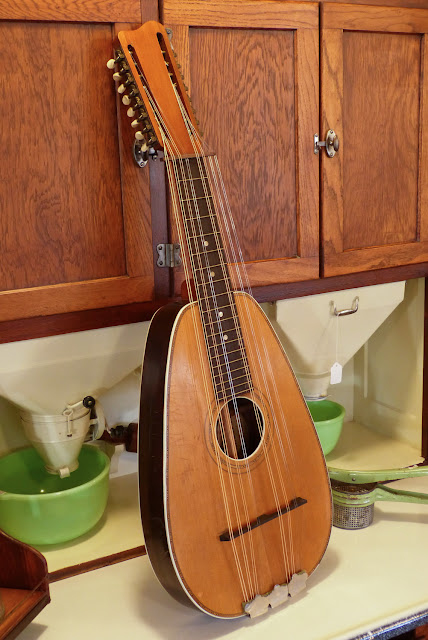1917 Tonaharp (Modified) Hawaiian Guitar
The Tonaharp exists in two versions and both were intended for the Hawaiian, lap-slide player. This is the first version and in its original form -- with 17 strings spread-out in "chord banks" -- it was, to put it mildly, inconvenient for the average musician to use. So, after shoring-up the damaged bits on this one, I decided to make use of its current condition (down one tuner which was broken) and made it into a double-neck Hawaiian guitar -- or, rather, more like a double-neck Hawaiian mandolin, as each bank of strings is four-course and doubled.
The "bass" side uses octave mandolin strings (46w-14) and I've tuned it either EBEB low to high or GDGB and the "treble" side uses mandolin strings (32w-9) and I've tuned it either CGCG or DADF#. An enterprising player can figure out just about any format or stringing depending on how he or she slots the nut and saddle, but I liked the simplification of this instrument into two "necks."
Construction-wise, it's basically like a ladder-braced guitar but without a waist. It has a thin, mandola/octave mandolin depth and there's a giant support beam that runs from the neck block to the endblock inside (to counteract all that tension). It has a 22" scale and the neck is actually straight, so someone of a crazy mind could, theoretically, modify it to be used "Spanish" style, but the neck itself is pretty giant and wouldn't lend itself to regular, fretted play.
I'm pretty sure that this was made by Regal or Lyon & Healy for the sellers who hocked this instrument (Boswell and Wilber in Schenectady, NY), as the construction details, materials, purfling choices, and whatnot are close to instruments made/sold by those brands at the time -- and Regal often made for Lyon & Healy, too, to confuse matters. Failing that, I would expect it to have been made by Harmony -- all in Chicago.
My repairs included regluing the headstock seams at the top (where they'd come loose), a new rosewood nut (to replace an original which also had "wings" but was damaged and shorter), modification of the bridge, replacement of a big section of binding on the top, various crack and seam repairs to the sides and back, and whatever other minor stuff needed doing.
The original bridge is ebonized maple and I re-ebonized the top edge after modifying it for the new stringing.
Three modified mandolin tailpiece secure the strings and I've added muting-foam to cut down on random overtones.
The top is solid spruce while the back and sides are solid birch painted in a "faux rosewood" look.
This section on the treble top-edge has replacement binding and some fill to make-up for mucked-up purfling.
The neck looks like it was reglued in the past ( a good job). You can see a little "pucker" in the side, here, which has been shored-up via filling/gluing it. There's also a tiny nail (hee hee) next to the heel that doesn't do anything structurally (I pulled it out to see), but I put it back in because I thought it was funny.
There's a longer, more-ugly "pucker" over here that has been addressed in the same way. They're both stable.
There are three hairline cracks on the back "lower bout" and all are glued and good to go.























Comments